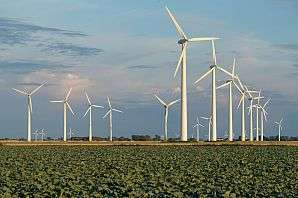Small wind farm with several turbines. Credit: sprisi /www.pixelio.de
Wind energy has been remarkably successful in providing an increasing share of cheap renewable energy. But can this trend continue to supply more and more renewable energy for decades to come? A new study published by scientists from the Max Planck Institute for Biogeochemistry in Jena, Germany, lowers the expectations of wind energy when used at large scales.
How much wind energy can at best be generated? And how efficient are turbines going to be when more and more turbines are needed to generate more renewable energy? These questions were addressed in a study just published in the Proceedings of the National Academy of Sciences. Every turbine removes energy from the winds, so that many turbines operating over large scales should reduce wind speeds of the atmospheric flow. With many turbines, this effect should extend beyond the immediate wake behind each turbine and result in a general reduction of wind speeds. This wind speed reduction is critical, as it lowers the amount of energy that each turbine can extract from the winds.
By accounting for this slowdown effect, the authors resolved a standing discrepancy between the high estimates for wind energy derived from local wind speed observations and small wind farms and the much lower estimates derived from large-scale estimates derived from climate models. Dr. Lee Miller, first author of the study, explains: "One should not assume that wind speeds are going to stay the same with a lot of wind turbines in a region. Wind speeds in climate models may not be completely realistic, but climate models can simulate the effect that many wind turbines have on wind speeds while observations cannot capture their effect." The wind speed reduction would dramatically lower the efficiency by which turbines generate electricity. The authors calculated that when wind energy is used at its maximum potential in a given region, each turbine in the presence of many other turbines generates on average only about 20% of the electricity compared to what an isolated turbine would generate.
The researchers applied a global climate model commonly used in climate research. They performed scenarios of different wind energy use across all continents to find out how much wind energy could at best be generated. On land, they determined that only 3-4% of land areas have the potential to generate more than 1.0 watt of electricity per square meter of land surface, with a more typical potential of about 0.5 watt per square meter or less. These estimates are similar to previous climate model studies, but about ten times lower than estimates based on observed wind speeds. This strong discrepancy is explained by the substantial 40 – 50% reduction of wind speeds in the climate model simulations. As wind speeds disproportionally affect the electricity generation of wind turbines, the lower wind speeds result in the much lower wind energy potential obtained by climate models.
Dr. Axel Kleidon, group leader at Max-Planck-Institute for Biogeochemistry, admits that these scenarios of wind energy are hypothetical. Yet, he sees the results as highly relevant for the future ex-pansion of wind energy. "We found these dramatic effects at turbine spacings commonly used in present-day wind farms on land." Kleidon plans to look into observations of present-day wind farms to see whether this effect can already be seen. This effect would imply that in order to maintain today's high turbine efficiencies and favorable economics, the future expansion of wind energy should probably proceed with much greater spacing between turbines than what is common to wind farms of today.
More information: Lee M. Miller et al. Wind speed reductions by large-scale wind turbine deployments lower turbine efficiencies and set low generation limits, Proceedings of the National Academy of Sciences (2016). DOI: 10.1073/pnas.1602253113
Journal information: Proceedings of the National Academy of Sciences
Provided by Max Planck Society





















